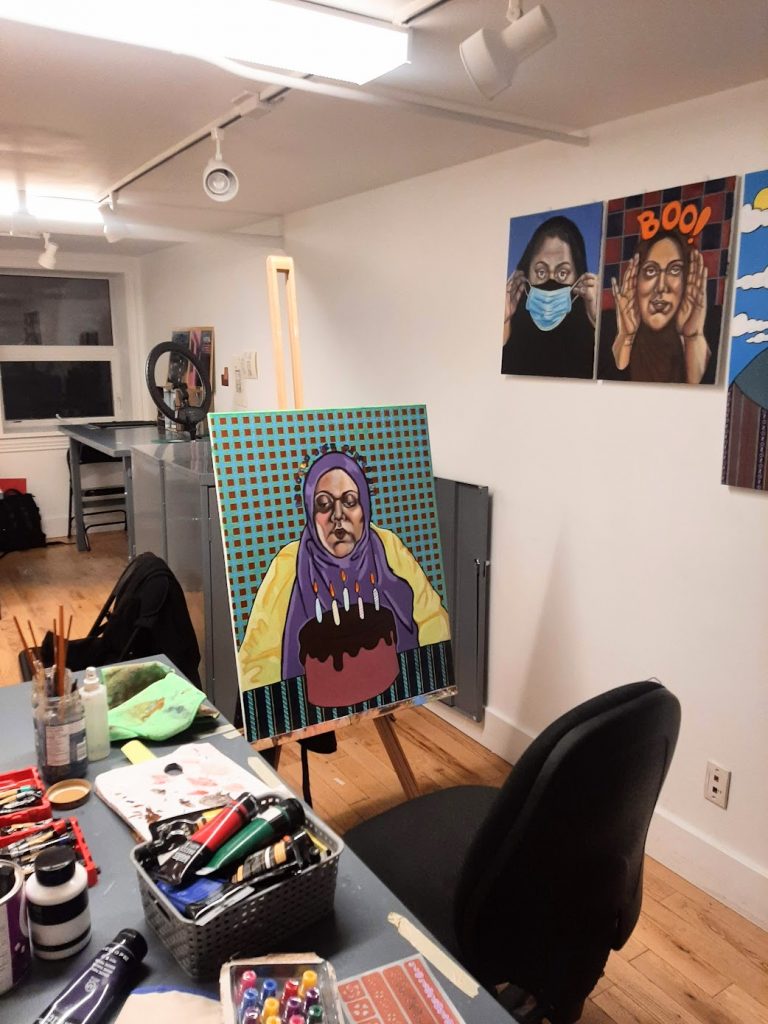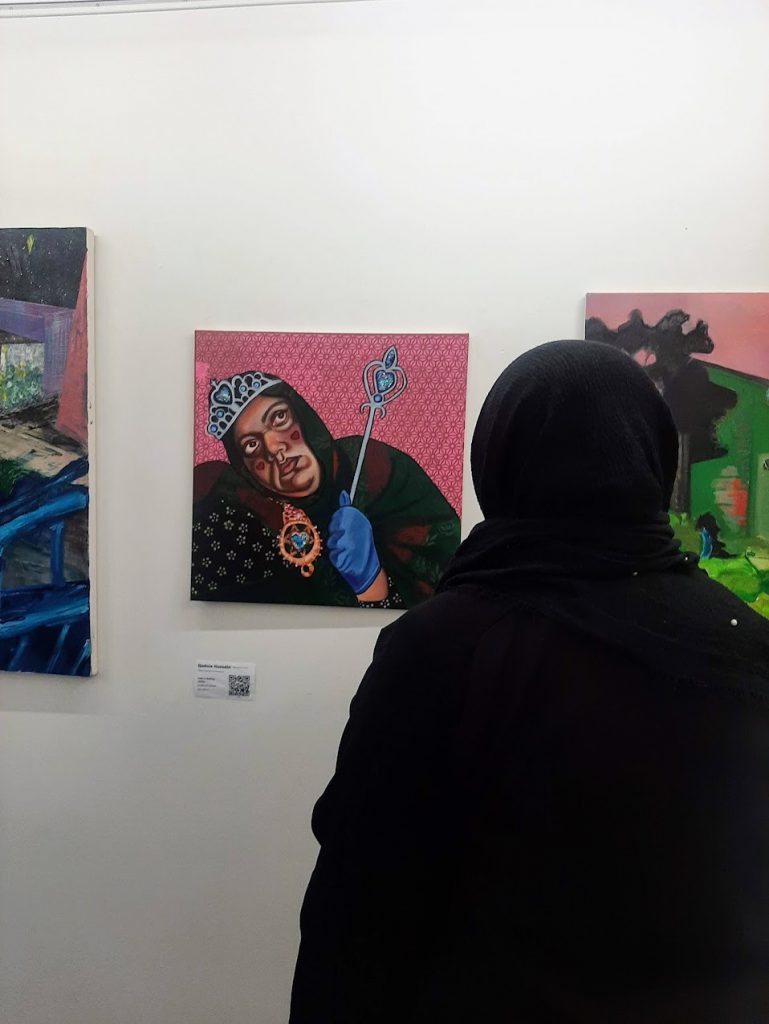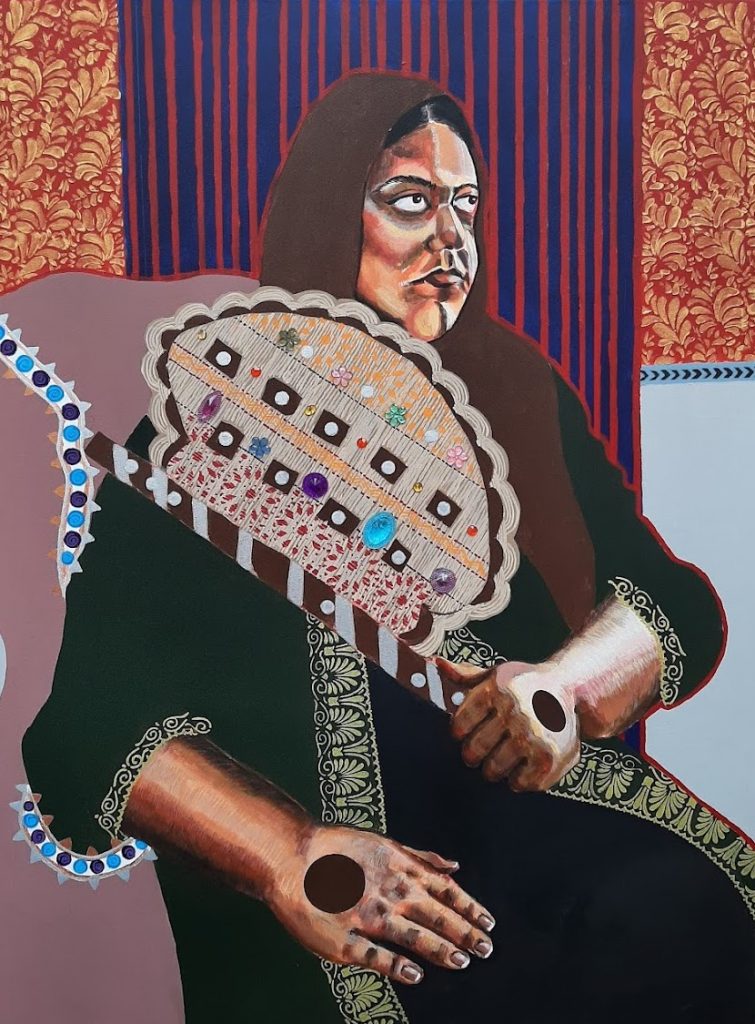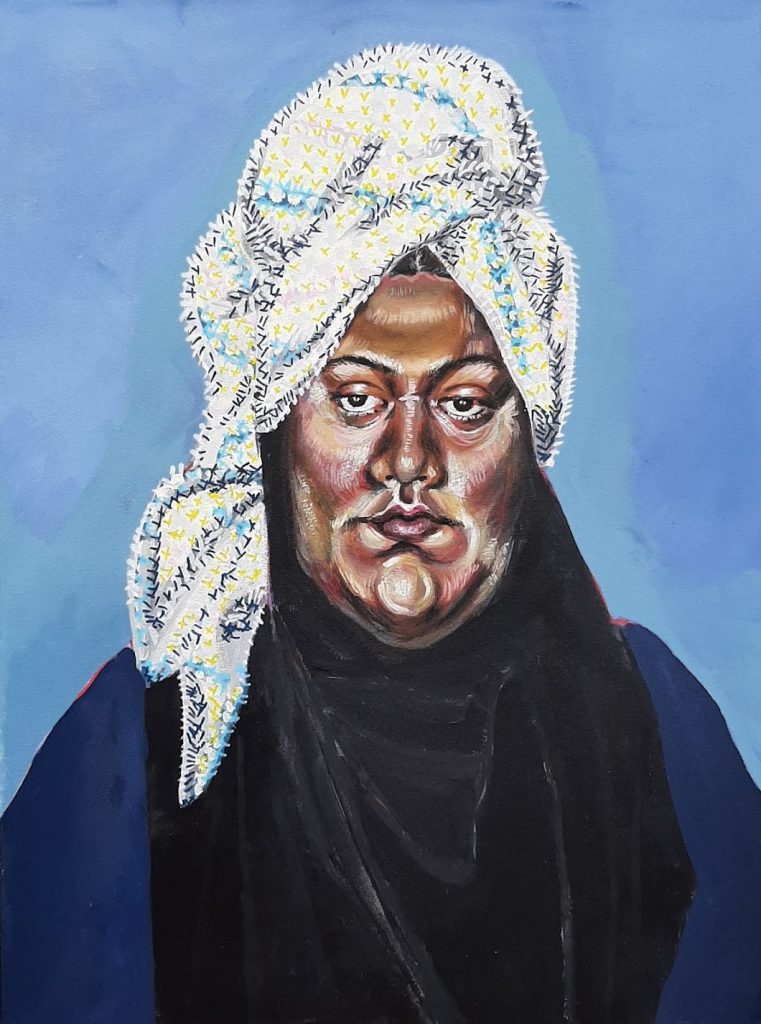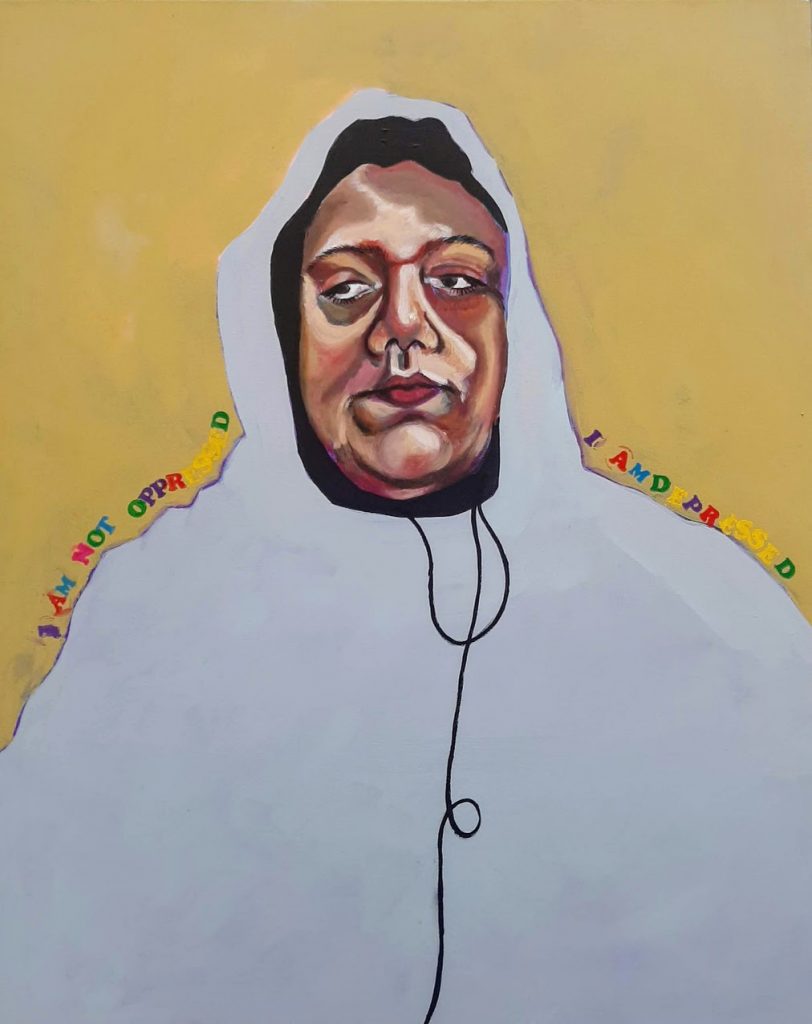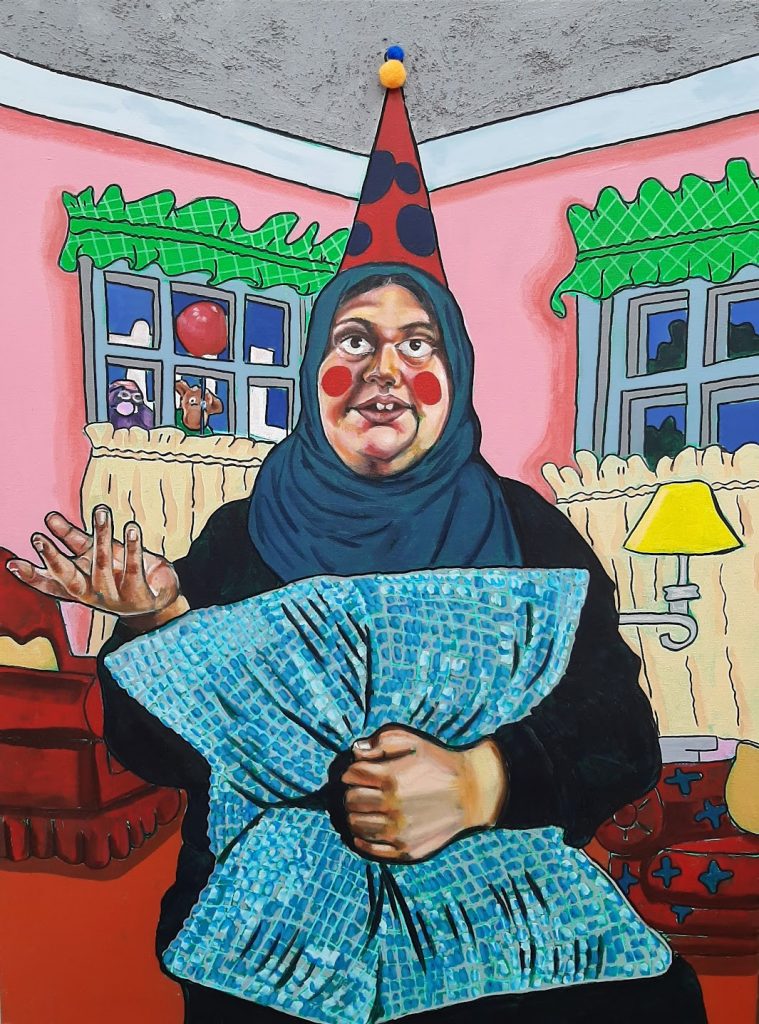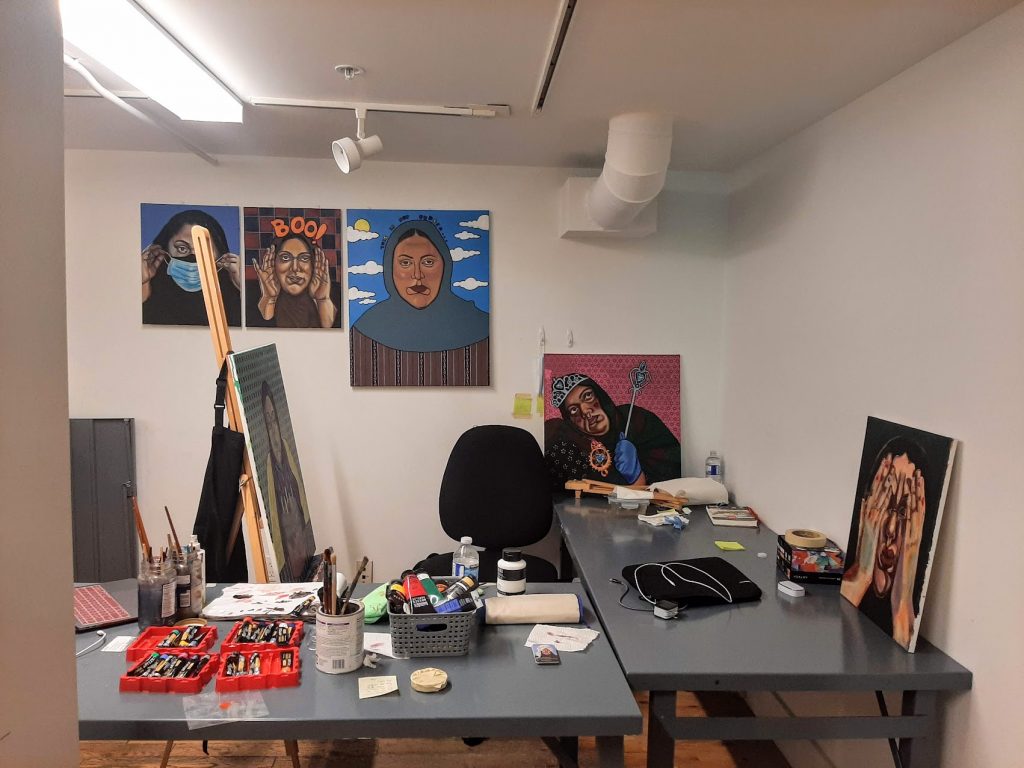In this series, we get to know the Artists behind the work with ten questions about their practice, their space, and their ideas. These are their Stories.
Qudsia Hussain
Qudsia Hussain is a Pakistani Canadian Muslim woman and recent graduate of OCAD University’s Drawing and Painting program. Her work weaves personal narratives, media references, cultural motifs, and childhood nostalgia into a compelling tapestry of the human experience. Having recently completed her artist residency at Gladstone House, Qudsia’s art stands as an introspective and compelling commentary on the multifaceted nature of individual and collective identity.
How did you discover your passion for art and decide to pursue it as a career?
My passion for art stemmed from growing up as a Pakistani, wearing beautiful bejewelled clothes for Eid, having traditional throw pillows on our couch or eating from the dishes my mom brought back from home. Our culture has so much beauty that I was always surrounded by art all the time.
Growing up with my sisters was a privilege; they are so inspirational. I remember when I was a kid; I would watch my older sister for hours putting henna on kids on chaad raat, each design different from the other; her process was so effortless, like it was her second nature. My second sister always had a keen eye for design; as children, she would create impeccable nail art with few materials and paint nails for anybody who asked. My younger sister was always a great storyteller and a comedic relief in our household. She would take bits and pieces from the TV shows she watched and invent interesting stories, giving them a fresh perspective. My sisters were creative and generous; at a moment’s notice, they were prepared to offer their art and brighten someone’s day. My sisters were the reason why I became so passionate about art.
As a child, I was never really talkative and very introverted. Inspired by my sisters, I started doodling away, and art became my safe haven. I was able to express myself through my art. Art became easy for me, something not complicated to understand. Art was the only subject I ever took seriously as a kid. I joined the art club and helped paint the Venice backdrop of our middle school production of Romeo and Juliet. Art was more than creating something but creating something together, sharing it and having a shared experience. From this, I started to take art more seriously and think more critically about myself as an individual, my positionality, social archetype and identity. I decided to pursue art as a career at the end of high school. I wanted to share my art with the world. I wanted to represent myself and have a shared experience when people view my paintings.
Tell us about your process when creating an artwork.
I believe that the process of creating art begins well before the initial concept for a painting. As an artist, I am constantly thinking about art while observing the world around me. I think it’s important to continuously challenge your mind as an artist. When I watch something, I try to find the underlying themes, how the actors/actresses convey emotion, or the space’s relevance to the storyline. While out for a walk, I notice how the shadows and the natural elements interact. When listening to music, I pay attention to the symbolism of the lyrics. I note down anything that interests me or make a doodle out of it.
I started to analyze how the themes of certain TV shows, the atmosphere of the space in movies and symbolism in the media relate to me and how I fit into all of this. I connect my personal experiences, who am I, what I am? and how I am perceived. What are my archetypes as an individual? Am I a protagonist or antagonist? What is the theme of my story, and what are the things that are symbolic to me? What obstacles are part of my hero journey?
With everything in mind, I make some rough drafts of an idea for a painting. The figure is the main focus of my painting. The figure sits in this liminal space of childhood nostalgia or an atmosphere of gloom with elements of cultural/religious motifs surrounding her. I go through an elimination process to see what works. Lastly, the painting process begins. I do the underpainting with a bright colour on canvas. I transfer the sketch to the canvas. I paint from the dark to the light values. Then, I paint the shadows and highlights and refine everything with details. I use stencils for the background or to imitate fabric and add gems to embellish some paintings.
In your work, you investigate themes surrounding your identity. Could you share some specific moments or experiences that have shaped your understanding of these themes and their significance in your art?
My paintings explore the idea of performing and becoming malleable to others. Social archetypes can sometimes affect how people perceive you in society. How is your identity being portrayed in the media? Are there any ramifications? How are you dealing with it?
Growing up as a Pakistani Muslim Woman who always wore a hijab on her head and wore Pakistani clothes from time to time, I always knew why people treated me differently. There was a difference in acknowledgement when I dressed in traditional black and colourful clothing. Being an immigrant child, I looked visibly different; many people assumed that I did not know how to speak English or comprehend anything. Uninvited conversations about faith that were meant to be learning experiences but became accusatory, asking me personal questions to support their stereotypes of me, are something I’ve dealt with.
The most important factor determining how people see you is your social archetype. Naturally, I am a very closed-off, introverted person, but due to my experiences, in certain situations, I make myself digestible; I overcompensate by smiling, laughing and agreeing. These are the personal narratives in my paintings. These are the things that I am thinking about in my art. What are my social archetypes as a Pakistani Canadian Muslim woman, am I perceived as a threat, oppressed or in need of help. I often address these matters in my paintings in a colourful, comedic way. Therefore, the theme of identity is very important in my work.
Your paintings incorporate personal narratives, media references, cultural motifs, and childhood nostalgia. How do these elements come together to convey your message or story?
My paintings consist of personal narratives, media references, cultural motifs and childhood nostalgia. All these elements come together in a painting to convey a story. All of these elements are part of me, part of my identity, and are telling my story.
The painting’s main focus is the figure, surrounded by various cultural motifs, as she sits in an atmosphere of liminal nostalgia. For example, In my painting titled Culture, the figure has henna on the hands while holding a traditional Pakistani hand fan.
Some of the backgrounds of my paintings are inspired by classic Islamic art or the living rooms of my favourite cartoons growing up. Media references are conveyed through the figure’s clothing. In one of my paintings, I wore a towel over a hijab to show the irony of how different a towel is from a hijab, demonstrating the stupidity of calling a Hijabi woman a towel head.
I also convey the references through the expression or dialogue; for example, in one of my paintings, the figure is surrounded by the words “I am not Oppressed; I am Depressed.” This phrase demonstrates a Muslim woman’s sadness can be because of mental health and not a stereotype.
The personal narrative is the story that I am trying to tell. A successful painting tries to tell a narrative. The other components should all work together to tell a story. In my painting Stuck, the personal narrative is childhood nostalgia. The figure is being pulled back to this liminal space of comfort while she tries to engage in conversation. The figure is holding onto the cushion, conveying anxiety as two fictional characters look through the window to see what is happening.
As an artist who has recently graduated from the drawing and painting program at OCAD University, what are your future artistic aspirations?
My future artistic aspiration is to continue to make art and hopefully have my solo exhibition.
Beyond your self-portraits and exploration of identity, are there any other themes or subjects you aspire to explore in your future artwork or any new techniques or mediums you’d like to experiment with?
I would like to explore the theme of clutter in relation to class and identity. Who is allowed to be materialistic? Another theme that I would like to explore is how we exist in different parallel universes of fulfilled dreams or different possibilities in our lives.
When you’re not immersed in your art, what are some of your favourite ways to unwind and find inspiration in your day-to-day life ?
My favourite way to unwind is to bake, learn new recipes, meet with friends or watch old Disney movies.
What do you listen to when you work?
I listen to Lana del Rey, The Weekend and Coke Studio when I paint.
What’s one item in your workspace you cannot live without?
My large table is one thing I cannot live without in my workspace. I’m a messy person, and when I create art, I get more messier. I must arrange all of my art supplies on the table since doing so helps my creative process get started.
Do you want to be featured? Join Partial as a Pro artist and e-mail us at hello@partial.gallery. We’d love to share your work.

